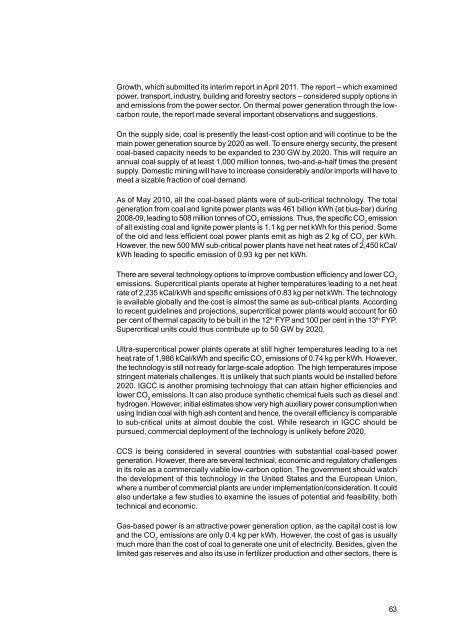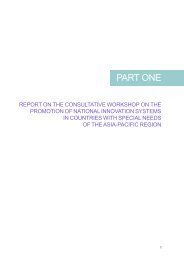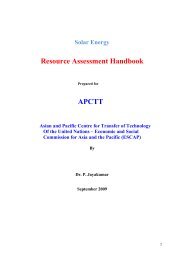Download Complete PDF - apctt
Download Complete PDF - apctt
Download Complete PDF - apctt
- No tags were found...
You also want an ePaper? Increase the reach of your titles
YUMPU automatically turns print PDFs into web optimized ePapers that Google loves.
Growth, which submitted its interim report in April 2011. The report – which examinedpower, transport, industry, building and forestry sectors – considered supply options inand emissions from the power sector. On thermal power generation through the lowcarbonroute, the report made several important observations and suggestions.On the supply side, coal is presently the least-cost option and will continue to be themain power generation source by 2020 as well. To ensure energy security, the presentcoal-based capacity needs to be expanded to 230 GW by 2020. This will require anannual coal supply of at least 1,000 million tonnes, two-and-a-half times the presentsupply. Domestic mining will have to increase considerably and/or imports will have tomeet a sizable fraction of coal demand.As of May 2010, all the coal-based plants were of sub-critical technology. The totalgeneration from coal and lignite power plants was 461 billion kWh (at bus-bar) during2008-09, leading to 508 million tonnes of CO 2emissions. Thus, the specific CO 2emissionof all existing coal and lignite power plants is 1.1 kg per net kWh for this period. Someof the old and less efficient coal power plants emit as high as 2 kg of CO 2per kWh.However, the new 500 MW sub-critical power plants have net heat rates of 2,450 kCal/kWh leading to specific emission of 0.93 kg per net kWh.There are several technology options to improve combustion efficiency and lower CO 2emissions. Supercritical plants operate at higher temperatures leading to a net heatrate of 2,235 kCal/kWh and specific emissions of 0.83 kg per net kWh. The technologyis available globally and the cost is almost the same as sub-critical plants. Accordingto recent guidelines and projections, supercritical power plants would account for 60per cent of thermal capacity to be built in the 12 th FYP and 100 per cent in the 13 th FYP.Supercritical units could thus contribute up to 50 GW by 2020.Ultra-supercritical power plants operate at still higher temperatures leading to a netheat rate of 1,986 kCal/kWh and specific CO 2emissions of 0.74 kg per kWh. However,the technology is still not ready for large-scale adoption. The high temperatures imposestringent materials challenges. It is unlikely that such plants would be installed before2020. IGCC is another promising technology that can attain higher efficiencies andlower CO 2emissions. It can also produce synthetic chemical fuels such as diesel andhydrogen. However, initial estimates show very high auxiliary power consumption whenusing Indian coal with high ash content and hence, the overall efficiency is comparableto sub-critical units at almost double the cost. While research in IGCC should bepursued, commercial deployment of the technology is unlikely before 2020.CCS is being considered in several countries with substantial coal-based powergeneration. However, there are several technical, economic and regulatory challengesin its role as a commercially viable low-carbon option. The government should watchthe development of this technology in the United States and the European Union,where a number of commercial plants are under implementation/consideration. It couldalso undertake a few studies to examine the issues of potential and feasibility, bothtechnical and economic.Gas-based power is an attractive power generation option, as the capital cost is lowand the CO 2emissions are only 0.4 kg per kWh. However, the cost of gas is usuallymuch more than the cost of coal to generate one unit of electricity. Besides, given thelimited gas reserves and also its use in fertilizer production and other sectors, there is63







